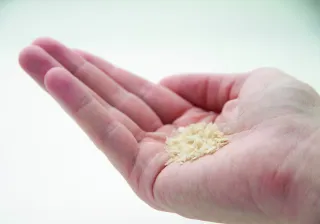New biomaterials are expected to respond to several global challenges, but their development can be frustratingly slow. A VTT-based team took to boosting synthetic biology with artificial intelligence (AI). Their ultimate goal is to reduce development time from years to minutes.
New biomaterials are expected to significantly reduce the use of fossil-based materials and also to bring game-changing properties to medicinal and other demanding applications. Expectations are often pointed at synthetic biology, which enables the production of complicated structures present in nature. For example, VTT research groups have successfully produced silk and egg white.
“The goal in synthetic biology is not only to imitate existing materials, but also to create new ones with excellent properties, such as elasticity, resilience, strength, and biodegradability,” says Pezhman Mohammadi, Research Scientist at VTT.
Synthetic biology uses microbes as cell factories, because they are good at producing proteins and other biochemicals using recipes encoded in their DNA or in modified DNA inserted in them. Which DNA sequences to insert, is the key question to scientists developing new biomaterials.
“There are enormous databases matching known protein structures with corresponding DNA sequences. This data gives us a good starting point, but creating a new functional material still requires a lot of lab work, usually years of trial and error,” Mohammadi says.
To Caj Södergård, Research Professor in Digital Services and AI at VTT, trial and error is a method preferably delegated to computers. So, he suggested cooperation between specialists in synthetic biology, artificial intelligence and molecular dynamics simulation.
At the beginning of 2021, a team of ten VTT scientists lead by Södergård started their joint project in the annual early-stage innovation programme, VTT iBEX. They called the project AIMS for AI empowered Material Scientist.
New biomaterials and new methods
The VTT iBEX programme launches and guides 10 one-year projects that arise from VTT researchers’ passion to change the world.
“VTT iBEX assigned us external business mentors and VTT based co-creation managers to help us evaluate our potential innovations and identify their stakeholders. This was an exciting combination of research and business goals,” Södergård says. According to him, the project has created valuable solutions in each field involved.
Novel deep learning and simulation methods created in the project helped material developers narrow down their search for protein structures and corresponding DNA sequences from thousands of candidates to 27 potential ones before stepping into their laboratory.
“There are commercial applications which aim to predict the position of every single atom, but it takes enormous amounts of computing power and time. Our goal was to predict the structure well enough and thus fast enough, and this is what we managed to do,” Södergård says.
“We are now synthesizing and testing selected new proteins, and they look really promising. They could possibly be used to create injectable materials for medicinal purposes, such as tooth transplants or drug delivery systems,” Mohammadi says.
To design a new material in minutes
Both Södergård and Mohammadi think that the VTT iBEX programme allowed them to take on an exceptionally challenging goal and combine forces across VTT.
“We were able to combine two exponentially developing technologies, synthetic biology and AI, to radically accelerate the design of new materials. We managed to speed up material design from years to months, and there is still potential to bring the time down to only minutes”, Mohammadi says.
Södergård points out that the project is a prime example of collaborative intelligence. Human experts and AI systems together make new discoveries that otherwise are beyond reach.









